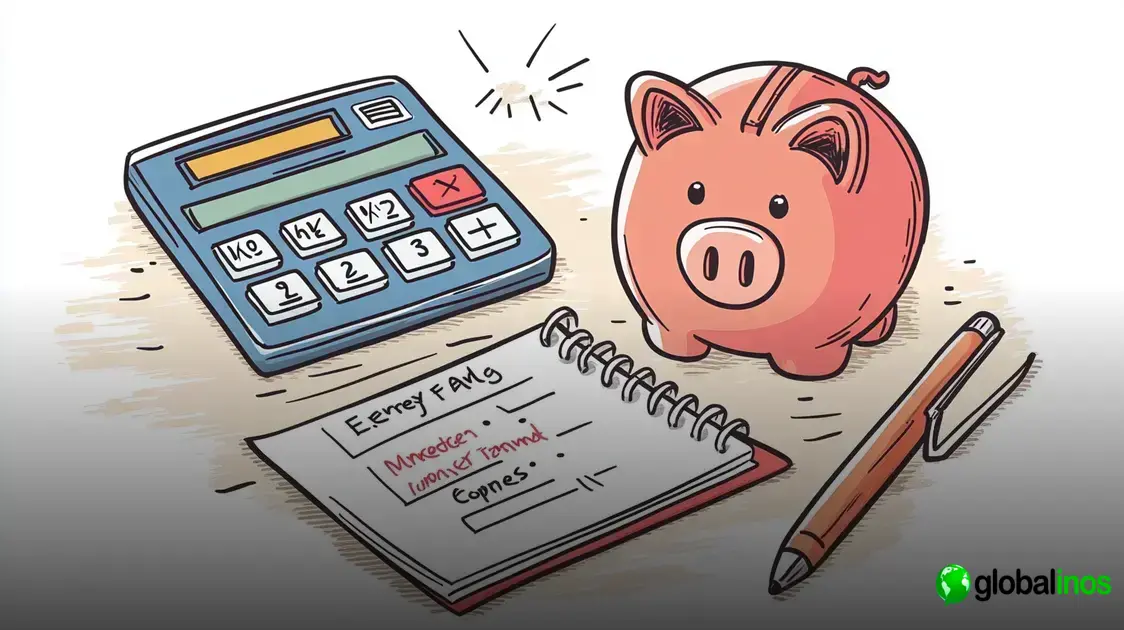Building an emergency fund is one of the smartest financial moves you can make. Life is unpredictable, and unexpected expenses like medical bills or car repairs can strain your finances. Having a dedicated fund prevents reliance on credit cards or loans.
A well-planned emergency fund acts as a financial cushion, offering peace of mind. Experts suggest saving three to six months of expenses, but even a small reserve helps. Setting aside money regularly builds financial security over time.
If you haven’t started building an emergency fund, now is the time. With the right approach, you can grow your savings step by step. Keep reading for simple strategies to start and maintain your fund.
What is an Emergency Fund?
An emergency fund is a dedicated savings account designed to cover unexpected expenses. These could include medical emergencies, car repairs, or job loss. Building an emergency fund ensures you have financial security during unforeseen circumstances, reducing the need for debt or high-interest loans.
Typically, building an emergency fund involves saving enough to cover three to six months of living expenses. The exact amount depends on your personal financial situation and living costs. This fund acts as a safety net, allowing you to manage financial shocks without disrupting your long-term goals.
A well-established emergency fund helps maintain financial stability when unexpected situations arise. Whether it’s sudden home repairs or medical bills, building an emergency fund gives you the confidence to handle emergencies without financial stress.
Choosing the right account is key to building an emergency fund successfully. A high-yield savings or money market account can keep your funds accessible while earning interest, ensuring your savings grow while staying protected.
Why is an Emergency Fund Important?
Building an emergency fund is crucial for financial stability, acting as a safety net against unexpected expenses. Instead of relying on credit cards or loans, having dedicated savings allows you to handle emergencies without falling into debt.
Enhances Financial Security
With building an emergency fund, you gain financial security and peace of mind. Knowing you have money set aside for emergencies reduces stress, allowing you to focus on daily life without the constant fear of unexpected costs.
Prevents Undue Debt
Unexpected expenses, such as car repairs or medical bills, can quickly lead to credit card debt. Building an emergency fund helps you cover these costs without accumulating high-interest debt, keeping your finances in check.
Supports Long-Term Goals
When you don’t have to worry about financial crises, you can focus on long-term goals like buying a home or saving for retirement. Building an emergency fund allows for better planning, ensuring you stay on track toward financial success.
How Much Should You Save?

How Much Should You Save? The amount to save in your emergency fund can vary based on your individual circumstances. A general guideline suggests saving enough to cover three to six months’ worth of living expenses. This amount ensures that you are prepared for significant unexpected costs.
Calculating Your Needs: To determine how much you should save, start by calculating your monthly expenses. Include essentials like rent or mortgage payments, utilities, groceries, transportation, and insurance. Multiply this total by three or six, depending on your comfort level and job stability.
Example: If your total monthly expenses are $3,000, aim for an emergency fund of $9,000 to $18,000. This gives you a safety net for several months, allowing you to manage life’s challenges without financial strain.
Consider Your Situation: Every individual’s situation is unique. If you work in a stable job, saving three months of expenses may be enough. However, if you’re a freelancer or have irregular income, aim for the higher end of six months to ensure you’re adequately covered.
Regularly Review Your Fund: As your financial situation changes, revisit your savings goal. Major life events like getting married, having a child, or changing jobs can affect your expenses. Adjusting your emergency fund accordingly is crucial to maintain your financial security.
Best Places to Keep Your Emergency Fund
Best Places to Keep Your Emergency Fund When building an emergency fund, selecting the right place to keep your savings is essential. You want your money to be safe and easily accessible when you need it the most.
High-Yield Savings Accounts: These accounts typically offer better interest rates than regular savings accounts, making them an excellent choice for your emergency fund. They provide easy access to your money while earning slightly more interest.
Money Market Accounts: Money market accounts combine features of savings and checking accounts. They usually offer higher interest rates and allow limited check writing or debit card access, which can be useful in emergencies.
Certificates of Deposit (CDs): CDs are time deposits that generally pay higher interest rates than savings accounts. However, your money is locked in for a specific period, which makes them less accessible. They can be a good option if you set up CDs with staggered maturity dates.
Online Banks: Many online banks offer competitive rates for savings and money market accounts since they have lower overhead costs than traditional banks. Compare rates and terms to find the best deals for your emergency fund.
Keeping Cash at Home: While not ideal for large amounts, having a small amount of cash at home can be handy during emergencies where immediate access is needed. Ensure it’s a safe place and remember that this won’t earn any interest.
Always weigh factors like accessibility, interest rates, and security when choosing the best place to keep your emergency fund. Keeping your funds in a mix of these options can also provide added security and convenience.
Tips for Building Your Emergency Fund
Establishing an emergency fund can seem challenging, but with simple strategies, you can start building an emergency fund quickly and effectively.
Set a Goal – Define how much you need in your fund and set milestones. A clear target will keep you motivated.
Create a Budget – Review your income and expenses to find areas where you can cut back. Redirect these savings to building an emergency fund consistently.
Automate Your Savings – Schedule automatic transfers to your savings account. Treat it like a fixed expense to ensure steady progress.
Save Windfalls – Direct unexpected money, such as tax refunds or bonuses, into your fund to boost savings faster.
Start Small – If saving a large amount feels overwhelming, begin with small, manageable contributions and increase them over time.
Keep It Separate – Store your emergency savings in a dedicated account to avoid unnecessary withdrawals.
Review Regularly – Periodically assess your fund and adjust your savings goal as expenses change.
By following these steps, building an emergency fund becomes an achievable and rewarding financial habit.
Common Mistakes to Avoid

Common Mistakes to Avoid Building an emergency fund is vital, but many people make mistakes that can hinder their progress. Being aware of these pitfalls can help you avoid them.
1. Not Setting a Specific Goal: One common mistake is not having a clear goal for how much to save. Without a target, it can be hard to stay motivated and measure your progress.
2. Dipping into Your Fund: Using your emergency fund for non-emergencies can be tempting. Remember, this money is meant for unexpected events only. Treat it as a last resort to avoid financial strain.
3. Saving in the Wrong Place: Keeping your emergency fund in accounts that earn little to no interest is a mistake. Make sure your money is in a high-yield savings account or a money market account to grow your savings.
4. Failing to Review Regularly: Life changes and so do your expenses. Not reviewing the amount in your emergency fund regularly can lead to being underprepared in case of unexpected costs.
5. Overlooking Small Contributions: Some people wait to start saving until they can put away large sums. Even small, regular contributions can add up over time, so start saving what you can now.
6. Ignoring Other Financial Goals: Focusing solely on your emergency fund while neglecting other financial goals, like retirement savings, can be a mistake. Aim for a balance that keeps all your financial objectives on track.
7. Getting Discouraged: Building an emergency fund can take time, and you may face setbacks. Don’t let this discourage you. Stick to your plan and make adjustments as needed.
How to Maintain Your Emergency Fund
How to Maintain Your Emergency Fund Keeping your emergency fund intact is important for long-term financial security. Here are simple strategies to help you maintain it effectively.
1. Regularly Review Your Fund: Assess your emergency fund at least once a year. As your financial situation changes, you may need to adjust the amount you save to ensure it meets your needs.
2. Update Your Savings Goal: Factors such as increases in monthly expenses or major life changes should prompt a reevaluation of how much you need in your emergency fund. Update your target as necessary to reflect your current situation.
3. Avoid Unnecessary Withdrawals: Only use your emergency fund for true emergencies. Avoid dipping into it for non-urgent expenses, as this can deplete your savings and compromise your financial safety net.
4. Refill After Withdrawals: If you must use your emergency fund, make it a priority to replenish it as soon as possible. Set a plan to transfer funds back to your savings to restore your safety net.
5. Maintain Discipline: Stay disciplined and keep your savings separate from your checking account. This reduces the temptation to spend emergency funds on regular expenses.
6. Automate Contributions: Continue to automate deposits into your emergency fund. This helps ensure you regularly contribute to it without thinking about it, maintaining your savings consistently.
7. Monitor Interest Rates: Keep an eye on interest rates for your savings account. If a better option becomes available, consider switching to maximize your savings growth.
FAQ – Frequently Asked Questions about Building an Emergency Fund
What is an emergency fund?
An emergency fund is a savings account set aside to cover unexpected expenses, such as medical emergencies or car repairs.
Why is it important to have an emergency fund?
An emergency fund provides financial security and peace of mind, protecting you from debt when unexpected costs arise.
How much should I save in my emergency fund?
Aim for three to six months’ worth of living expenses, depending on your individual situation and job stability.
Where is the best place to keep my emergency fund?
Consider keeping your emergency fund in a high-yield savings account or a money market account for safety and accessibility.
What are some tips for building my emergency fund?
Set a clear savings goal, create a budget, automate your savings, and save windfalls like bonuses or tax refunds.
What common mistakes should I avoid when building an emergency fund?
Avoid not setting a specific goal, dipping into your fund for non-emergencies, and saving in low-interest accounts.
Check out our article on Retirement Saving to learn effective strategies for securing your financial future and enjoying a comfortable retirement.





